Leadership Styles and Decision-Making in Varying Contexts
VerifiedAdded on 2019/12/18
|15
|5105
|169
Report
AI Summary
This assignment content is a collection of articles and research papers published between 2010 and 2017, covering various topics related to leadership, management, human resources, marketing, and organizational dynamics. The papers explore different aspects of leadership styles, decision-making processes, communication strategies, teamwork, trust, motivation factors, and organizational performance metrics.
Contribute Materials
Your contribution can guide someone’s learning journey. Share your
documents today.
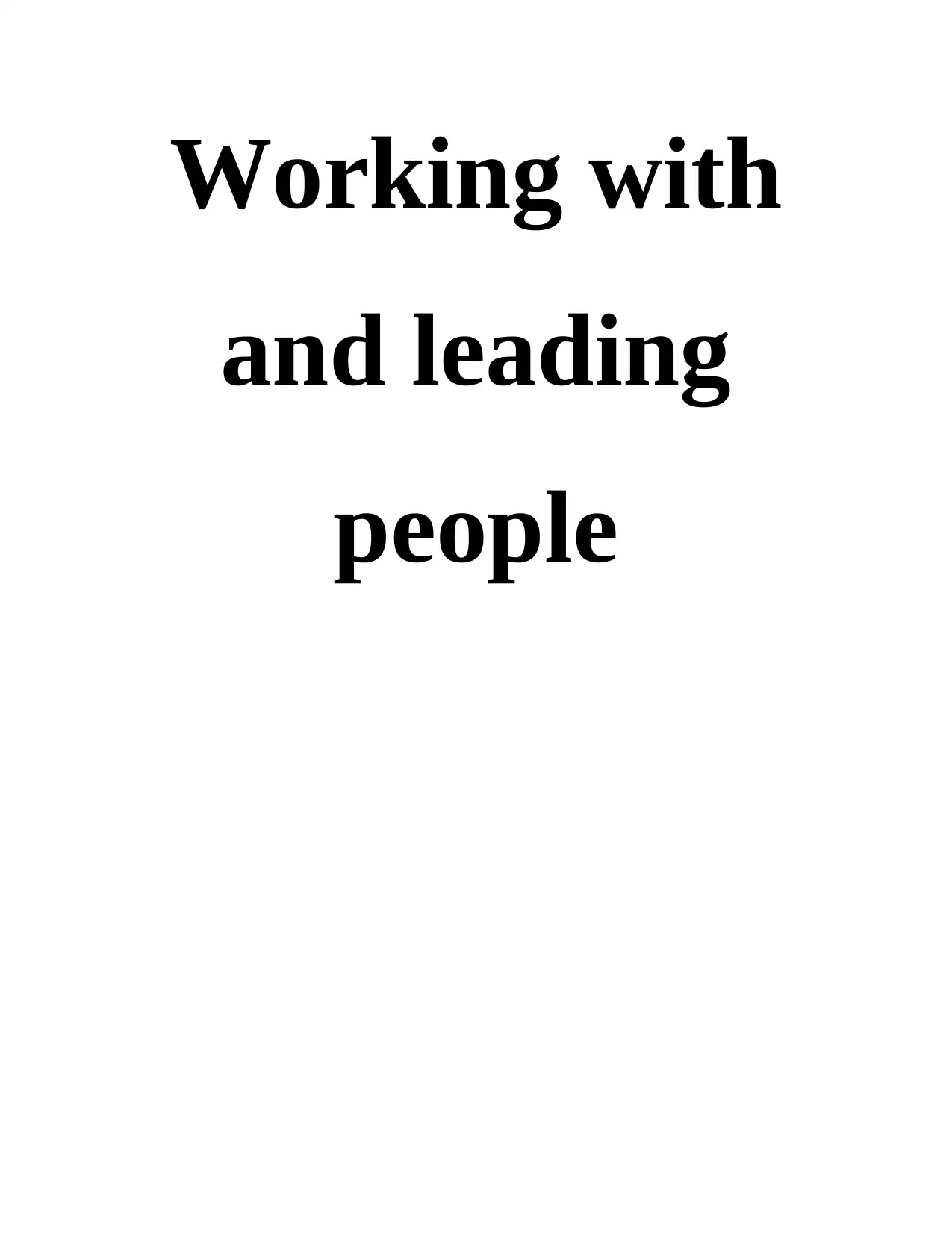
Working with
and leading
people
and leading
people
Secure Best Marks with AI Grader
Need help grading? Try our AI Grader for instant feedback on your assignments.
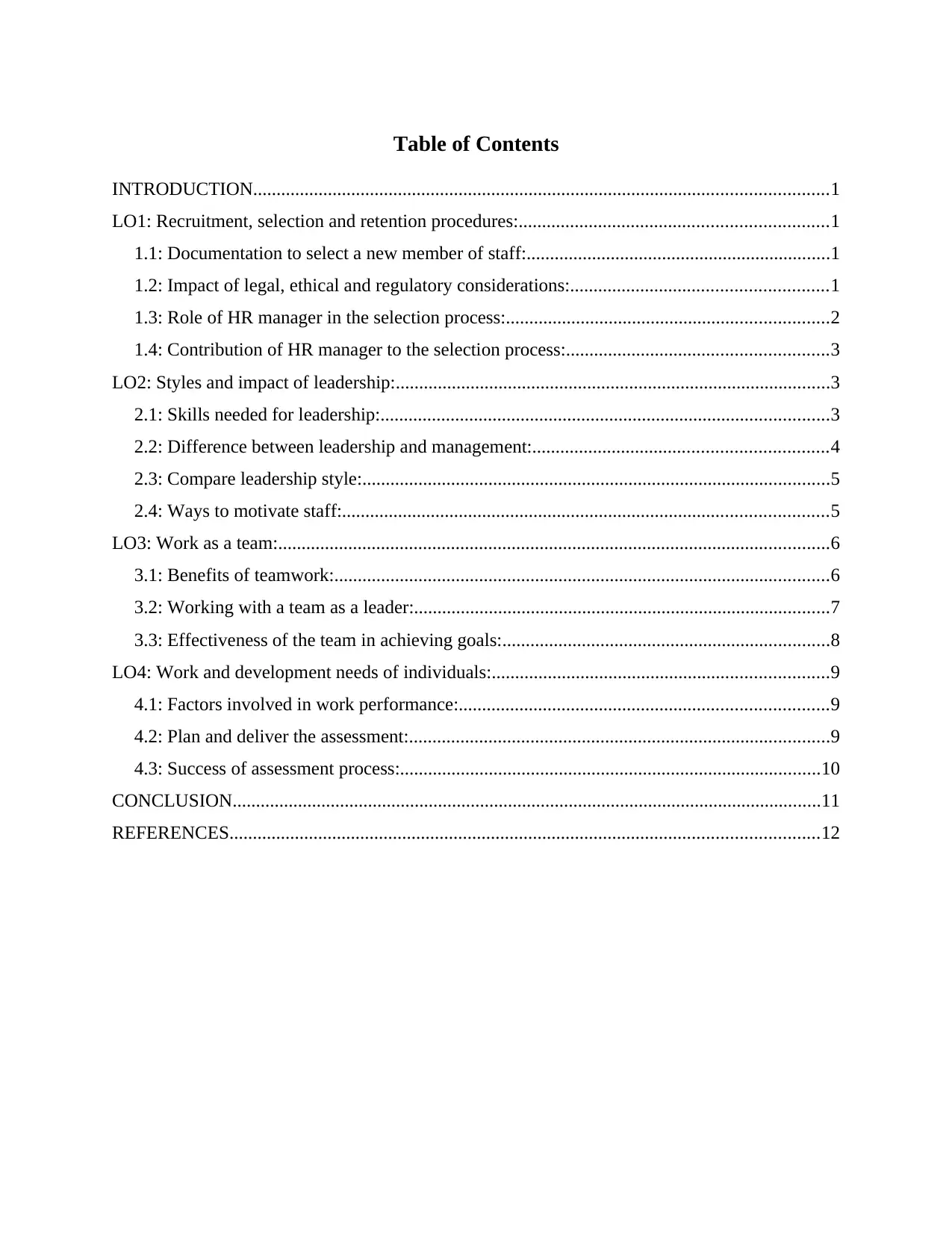
Table of Contents
INTRODUCTION...........................................................................................................................1
LO1: Recruitment, selection and retention procedures:..................................................................1
1.1: Documentation to select a new member of staff:.................................................................1
1.2: Impact of legal, ethical and regulatory considerations:.......................................................1
1.3: Role of HR manager in the selection process:.....................................................................2
1.4: Contribution of HR manager to the selection process:........................................................3
LO2: Styles and impact of leadership:.............................................................................................3
2.1: Skills needed for leadership:................................................................................................3
2.2: Difference between leadership and management:...............................................................4
2.3: Compare leadership style:....................................................................................................5
2.4: Ways to motivate staff:........................................................................................................5
LO3: Work as a team:......................................................................................................................6
3.1: Benefits of teamwork:..........................................................................................................6
3.2: Working with a team as a leader:.........................................................................................7
3.3: Effectiveness of the team in achieving goals:......................................................................8
LO4: Work and development needs of individuals:........................................................................9
4.1: Factors involved in work performance:...............................................................................9
4.2: Plan and deliver the assessment:..........................................................................................9
4.3: Success of assessment process:..........................................................................................10
CONCLUSION..............................................................................................................................11
REFERENCES..............................................................................................................................12
INTRODUCTION...........................................................................................................................1
LO1: Recruitment, selection and retention procedures:..................................................................1
1.1: Documentation to select a new member of staff:.................................................................1
1.2: Impact of legal, ethical and regulatory considerations:.......................................................1
1.3: Role of HR manager in the selection process:.....................................................................2
1.4: Contribution of HR manager to the selection process:........................................................3
LO2: Styles and impact of leadership:.............................................................................................3
2.1: Skills needed for leadership:................................................................................................3
2.2: Difference between leadership and management:...............................................................4
2.3: Compare leadership style:....................................................................................................5
2.4: Ways to motivate staff:........................................................................................................5
LO3: Work as a team:......................................................................................................................6
3.1: Benefits of teamwork:..........................................................................................................6
3.2: Working with a team as a leader:.........................................................................................7
3.3: Effectiveness of the team in achieving goals:......................................................................8
LO4: Work and development needs of individuals:........................................................................9
4.1: Factors involved in work performance:...............................................................................9
4.2: Plan and deliver the assessment:..........................................................................................9
4.3: Success of assessment process:..........................................................................................10
CONCLUSION..............................................................................................................................11
REFERENCES..............................................................................................................................12
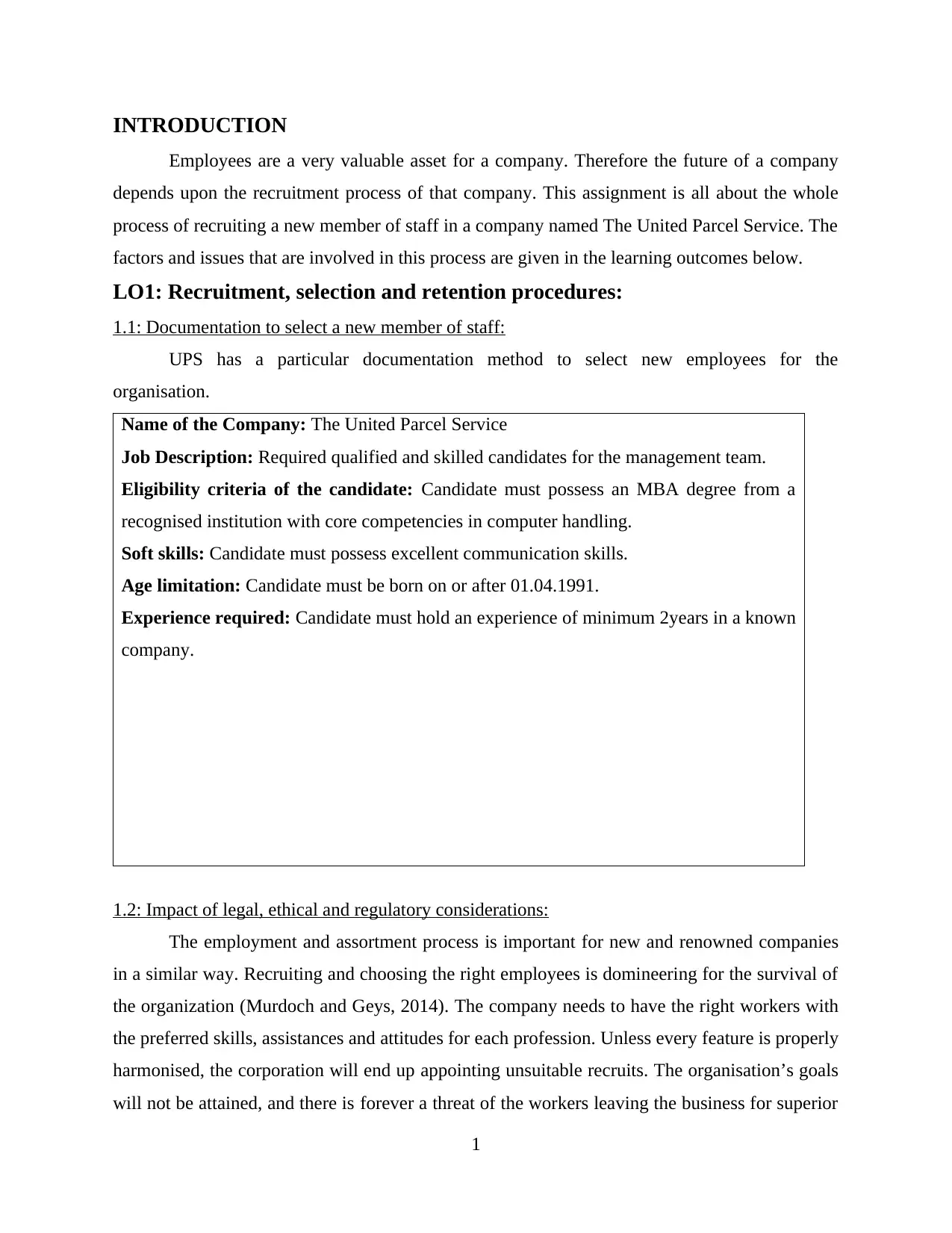
INTRODUCTION
Employees are a very valuable asset for a company. Therefore the future of a company
depends upon the recruitment process of that company. This assignment is all about the whole
process of recruiting a new member of staff in a company named The United Parcel Service. The
factors and issues that are involved in this process are given in the learning outcomes below.
LO1: Recruitment, selection and retention procedures:
1.1: Documentation to select a new member of staff:
UPS has a particular documentation method to select new employees for the
organisation.
Name of the Company: The United Parcel Service
Job Description: Required qualified and skilled candidates for the management team.
Eligibility criteria of the candidate: Candidate must possess an MBA degree from a
recognised institution with core competencies in computer handling.
Soft skills: Candidate must possess excellent communication skills.
Age limitation: Candidate must be born on or after 01.04.1991.
Experience required: Candidate must hold an experience of minimum 2years in a known
company.
1.2: Impact of legal, ethical and regulatory considerations:
The employment and assortment process is important for new and renowned companies
in a similar way. Recruiting and choosing the right employees is domineering for the survival of
the organization (Murdoch and Geys, 2014). The company needs to have the right workers with
the preferred skills, assistances and attitudes for each profession. Unless every feature is properly
harmonised, the corporation will end up appointing unsuitable recruits. The organisation’s goals
will not be attained, and there is forever a threat of the workers leaving the business for superior
1
Employees are a very valuable asset for a company. Therefore the future of a company
depends upon the recruitment process of that company. This assignment is all about the whole
process of recruiting a new member of staff in a company named The United Parcel Service. The
factors and issues that are involved in this process are given in the learning outcomes below.
LO1: Recruitment, selection and retention procedures:
1.1: Documentation to select a new member of staff:
UPS has a particular documentation method to select new employees for the
organisation.
Name of the Company: The United Parcel Service
Job Description: Required qualified and skilled candidates for the management team.
Eligibility criteria of the candidate: Candidate must possess an MBA degree from a
recognised institution with core competencies in computer handling.
Soft skills: Candidate must possess excellent communication skills.
Age limitation: Candidate must be born on or after 01.04.1991.
Experience required: Candidate must hold an experience of minimum 2years in a known
company.
1.2: Impact of legal, ethical and regulatory considerations:
The employment and assortment process is important for new and renowned companies
in a similar way. Recruiting and choosing the right employees is domineering for the survival of
the organization (Murdoch and Geys, 2014). The company needs to have the right workers with
the preferred skills, assistances and attitudes for each profession. Unless every feature is properly
harmonised, the corporation will end up appointing unsuitable recruits. The organisation’s goals
will not be attained, and there is forever a threat of the workers leaving the business for superior
1
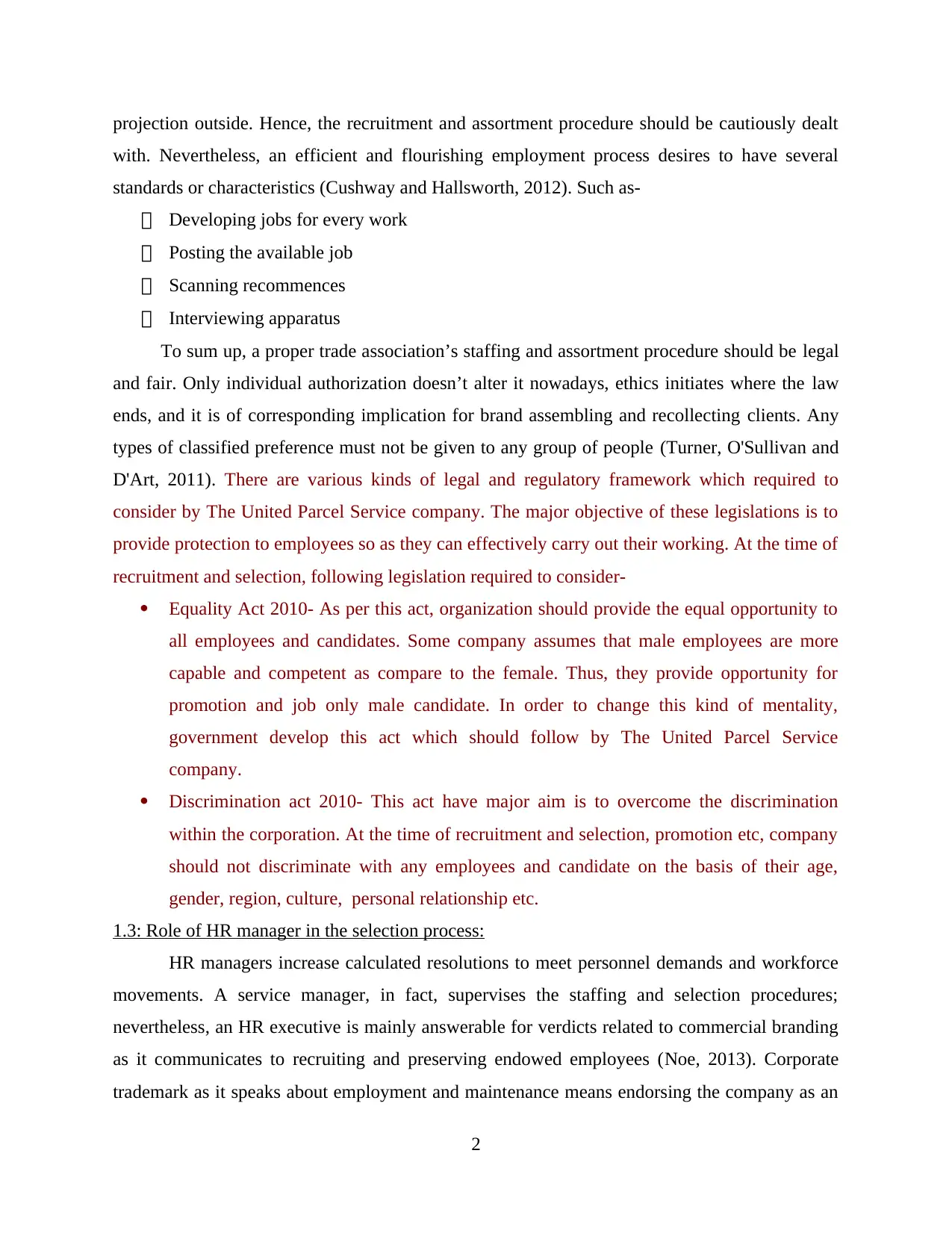
projection outside. Hence, the recruitment and assortment procedure should be cautiously dealt
with. Nevertheless, an efficient and flourishing employment process desires to have several
standards or characteristics (Cushway and Hallsworth, 2012). Such as-
Developing jobs for every work
Posting the available job
Scanning recommences
Interviewing apparatus
To sum up, a proper trade association’s staffing and assortment procedure should be legal
and fair. Only individual authorization doesn’t alter it nowadays, ethics initiates where the law
ends, and it is of corresponding implication for brand assembling and recollecting clients. Any
types of classified preference must not be given to any group of people (Turner, O'Sullivan and
D'Art, 2011). There are various kinds of legal and regulatory framework which required to
consider by The United Parcel Service company. The major objective of these legislations is to
provide protection to employees so as they can effectively carry out their working. At the time of
recruitment and selection, following legislation required to consider-
Equality Act 2010- As per this act, organization should provide the equal opportunity to
all employees and candidates. Some company assumes that male employees are more
capable and competent as compare to the female. Thus, they provide opportunity for
promotion and job only male candidate. In order to change this kind of mentality,
government develop this act which should follow by The United Parcel Service
company.
Discrimination act 2010- This act have major aim is to overcome the discrimination
within the corporation. At the time of recruitment and selection, promotion etc, company
should not discriminate with any employees and candidate on the basis of their age,
gender, region, culture, personal relationship etc.
1.3: Role of HR manager in the selection process:
HR managers increase calculated resolutions to meet personnel demands and workforce
movements. A service manager, in fact, supervises the staffing and selection procedures;
nevertheless, an HR executive is mainly answerable for verdicts related to commercial branding
as it communicates to recruiting and preserving endowed employees (Noe, 2013). Corporate
trademark as it speaks about employment and maintenance means endorsing the company as an
2
with. Nevertheless, an efficient and flourishing employment process desires to have several
standards or characteristics (Cushway and Hallsworth, 2012). Such as-
Developing jobs for every work
Posting the available job
Scanning recommences
Interviewing apparatus
To sum up, a proper trade association’s staffing and assortment procedure should be legal
and fair. Only individual authorization doesn’t alter it nowadays, ethics initiates where the law
ends, and it is of corresponding implication for brand assembling and recollecting clients. Any
types of classified preference must not be given to any group of people (Turner, O'Sullivan and
D'Art, 2011). There are various kinds of legal and regulatory framework which required to
consider by The United Parcel Service company. The major objective of these legislations is to
provide protection to employees so as they can effectively carry out their working. At the time of
recruitment and selection, following legislation required to consider-
Equality Act 2010- As per this act, organization should provide the equal opportunity to
all employees and candidates. Some company assumes that male employees are more
capable and competent as compare to the female. Thus, they provide opportunity for
promotion and job only male candidate. In order to change this kind of mentality,
government develop this act which should follow by The United Parcel Service
company.
Discrimination act 2010- This act have major aim is to overcome the discrimination
within the corporation. At the time of recruitment and selection, promotion etc, company
should not discriminate with any employees and candidate on the basis of their age,
gender, region, culture, personal relationship etc.
1.3: Role of HR manager in the selection process:
HR managers increase calculated resolutions to meet personnel demands and workforce
movements. A service manager, in fact, supervises the staffing and selection procedures;
nevertheless, an HR executive is mainly answerable for verdicts related to commercial branding
as it communicates to recruiting and preserving endowed employees (Noe, 2013). Corporate
trademark as it speaks about employment and maintenance means endorsing the company as an
2
Secure Best Marks with AI Grader
Need help grading? Try our AI Grader for instant feedback on your assignments.
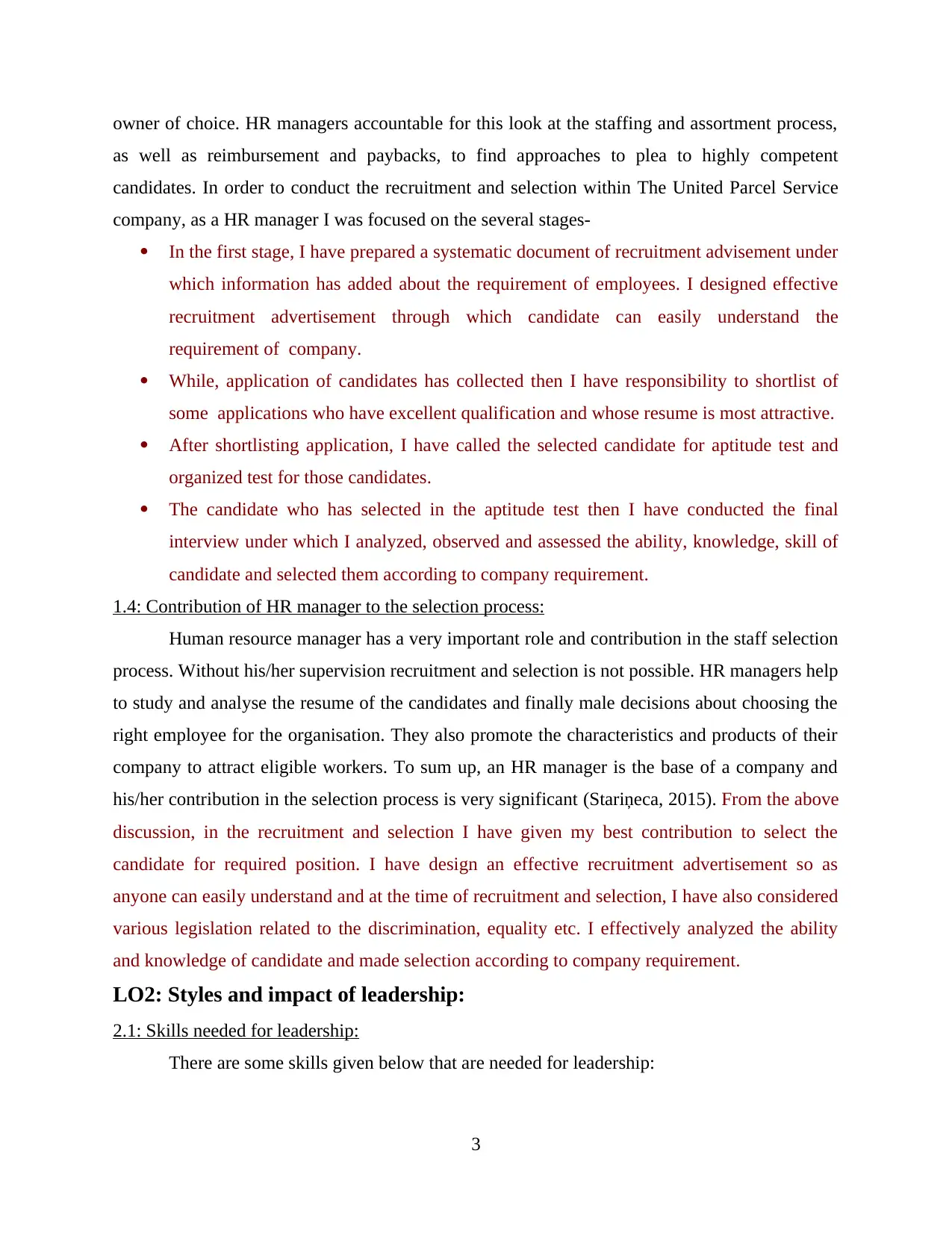
owner of choice. HR managers accountable for this look at the staffing and assortment process,
as well as reimbursement and paybacks, to find approaches to plea to highly competent
candidates. In order to conduct the recruitment and selection within The United Parcel Service
company, as a HR manager I was focused on the several stages-
In the first stage, I have prepared a systematic document of recruitment advisement under
which information has added about the requirement of employees. I designed effective
recruitment advertisement through which candidate can easily understand the
requirement of company.
While, application of candidates has collected then I have responsibility to shortlist of
some applications who have excellent qualification and whose resume is most attractive.
After shortlisting application, I have called the selected candidate for aptitude test and
organized test for those candidates.
The candidate who has selected in the aptitude test then I have conducted the final
interview under which I analyzed, observed and assessed the ability, knowledge, skill of
candidate and selected them according to company requirement.
1.4: Contribution of HR manager to the selection process:
Human resource manager has a very important role and contribution in the staff selection
process. Without his/her supervision recruitment and selection is not possible. HR managers help
to study and analyse the resume of the candidates and finally male decisions about choosing the
right employee for the organisation. They also promote the characteristics and products of their
company to attract eligible workers. To sum up, an HR manager is the base of a company and
his/her contribution in the selection process is very significant (Stariņeca, 2015). From the above
discussion, in the recruitment and selection I have given my best contribution to select the
candidate for required position. I have design an effective recruitment advertisement so as
anyone can easily understand and at the time of recruitment and selection, I have also considered
various legislation related to the discrimination, equality etc. I effectively analyzed the ability
and knowledge of candidate and made selection according to company requirement.
LO2: Styles and impact of leadership:
2.1: Skills needed for leadership:
There are some skills given below that are needed for leadership:
3
as well as reimbursement and paybacks, to find approaches to plea to highly competent
candidates. In order to conduct the recruitment and selection within The United Parcel Service
company, as a HR manager I was focused on the several stages-
In the first stage, I have prepared a systematic document of recruitment advisement under
which information has added about the requirement of employees. I designed effective
recruitment advertisement through which candidate can easily understand the
requirement of company.
While, application of candidates has collected then I have responsibility to shortlist of
some applications who have excellent qualification and whose resume is most attractive.
After shortlisting application, I have called the selected candidate for aptitude test and
organized test for those candidates.
The candidate who has selected in the aptitude test then I have conducted the final
interview under which I analyzed, observed and assessed the ability, knowledge, skill of
candidate and selected them according to company requirement.
1.4: Contribution of HR manager to the selection process:
Human resource manager has a very important role and contribution in the staff selection
process. Without his/her supervision recruitment and selection is not possible. HR managers help
to study and analyse the resume of the candidates and finally male decisions about choosing the
right employee for the organisation. They also promote the characteristics and products of their
company to attract eligible workers. To sum up, an HR manager is the base of a company and
his/her contribution in the selection process is very significant (Stariņeca, 2015). From the above
discussion, in the recruitment and selection I have given my best contribution to select the
candidate for required position. I have design an effective recruitment advertisement so as
anyone can easily understand and at the time of recruitment and selection, I have also considered
various legislation related to the discrimination, equality etc. I effectively analyzed the ability
and knowledge of candidate and made selection according to company requirement.
LO2: Styles and impact of leadership:
2.1: Skills needed for leadership:
There are some skills given below that are needed for leadership:
3
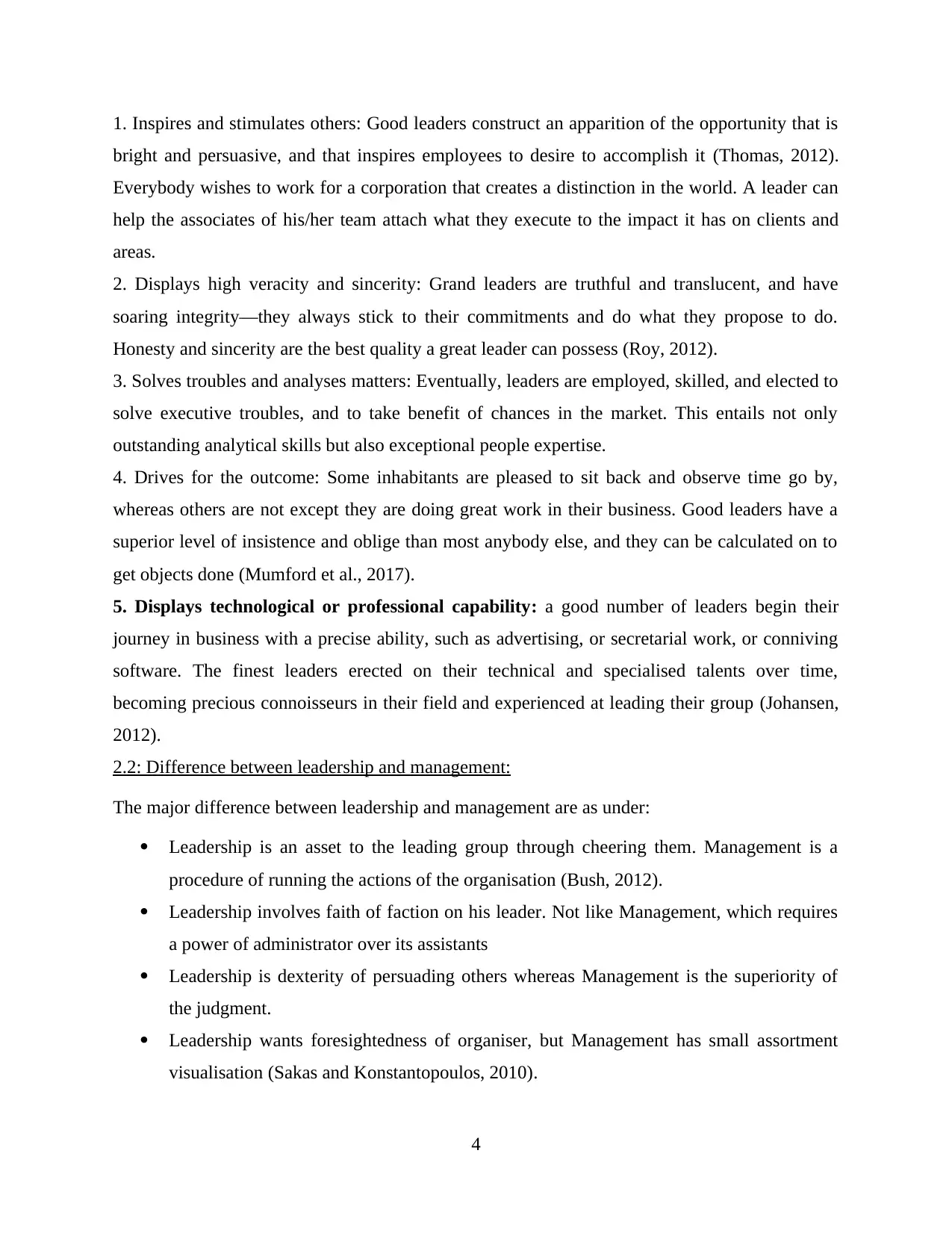
1. Inspires and stimulates others: Good leaders construct an apparition of the opportunity that is
bright and persuasive, and that inspires employees to desire to accomplish it (Thomas, 2012).
Everybody wishes to work for a corporation that creates a distinction in the world. A leader can
help the associates of his/her team attach what they execute to the impact it has on clients and
areas.
2. Displays high veracity and sincerity: Grand leaders are truthful and translucent, and have
soaring integrity—they always stick to their commitments and do what they propose to do.
Honesty and sincerity are the best quality a great leader can possess (Roy, 2012).
3. Solves troubles and analyses matters: Eventually, leaders are employed, skilled, and elected to
solve executive troubles, and to take benefit of chances in the market. This entails not only
outstanding analytical skills but also exceptional people expertise.
4. Drives for the outcome: Some inhabitants are pleased to sit back and observe time go by,
whereas others are not except they are doing great work in their business. Good leaders have a
superior level of insistence and oblige than most anybody else, and they can be calculated on to
get objects done (Mumford et al., 2017).
5. Displays technological or professional capability: a good number of leaders begin their
journey in business with a precise ability, such as advertising, or secretarial work, or conniving
software. The finest leaders erected on their technical and specialised talents over time,
becoming precious connoisseurs in their field and experienced at leading their group (Johansen,
2012).
2.2: Difference between leadership and management:
The major difference between leadership and management are as under:
Leadership is an asset to the leading group through cheering them. Management is a
procedure of running the actions of the organisation (Bush, 2012).
Leadership involves faith of faction on his leader. Not like Management, which requires
a power of administrator over its assistants
Leadership is dexterity of persuading others whereas Management is the superiority of
the judgment.
Leadership wants foresightedness of organiser, but Management has small assortment
visualisation (Sakas and Konstantopoulos, 2010).
4
bright and persuasive, and that inspires employees to desire to accomplish it (Thomas, 2012).
Everybody wishes to work for a corporation that creates a distinction in the world. A leader can
help the associates of his/her team attach what they execute to the impact it has on clients and
areas.
2. Displays high veracity and sincerity: Grand leaders are truthful and translucent, and have
soaring integrity—they always stick to their commitments and do what they propose to do.
Honesty and sincerity are the best quality a great leader can possess (Roy, 2012).
3. Solves troubles and analyses matters: Eventually, leaders are employed, skilled, and elected to
solve executive troubles, and to take benefit of chances in the market. This entails not only
outstanding analytical skills but also exceptional people expertise.
4. Drives for the outcome: Some inhabitants are pleased to sit back and observe time go by,
whereas others are not except they are doing great work in their business. Good leaders have a
superior level of insistence and oblige than most anybody else, and they can be calculated on to
get objects done (Mumford et al., 2017).
5. Displays technological or professional capability: a good number of leaders begin their
journey in business with a precise ability, such as advertising, or secretarial work, or conniving
software. The finest leaders erected on their technical and specialised talents over time,
becoming precious connoisseurs in their field and experienced at leading their group (Johansen,
2012).
2.2: Difference between leadership and management:
The major difference between leadership and management are as under:
Leadership is an asset to the leading group through cheering them. Management is a
procedure of running the actions of the organisation (Bush, 2012).
Leadership involves faith of faction on his leader. Not like Management, which requires
a power of administrator over its assistants
Leadership is dexterity of persuading others whereas Management is the superiority of
the judgment.
Leadership wants foresightedness of organiser, but Management has small assortment
visualisation (Sakas and Konstantopoulos, 2010).
4
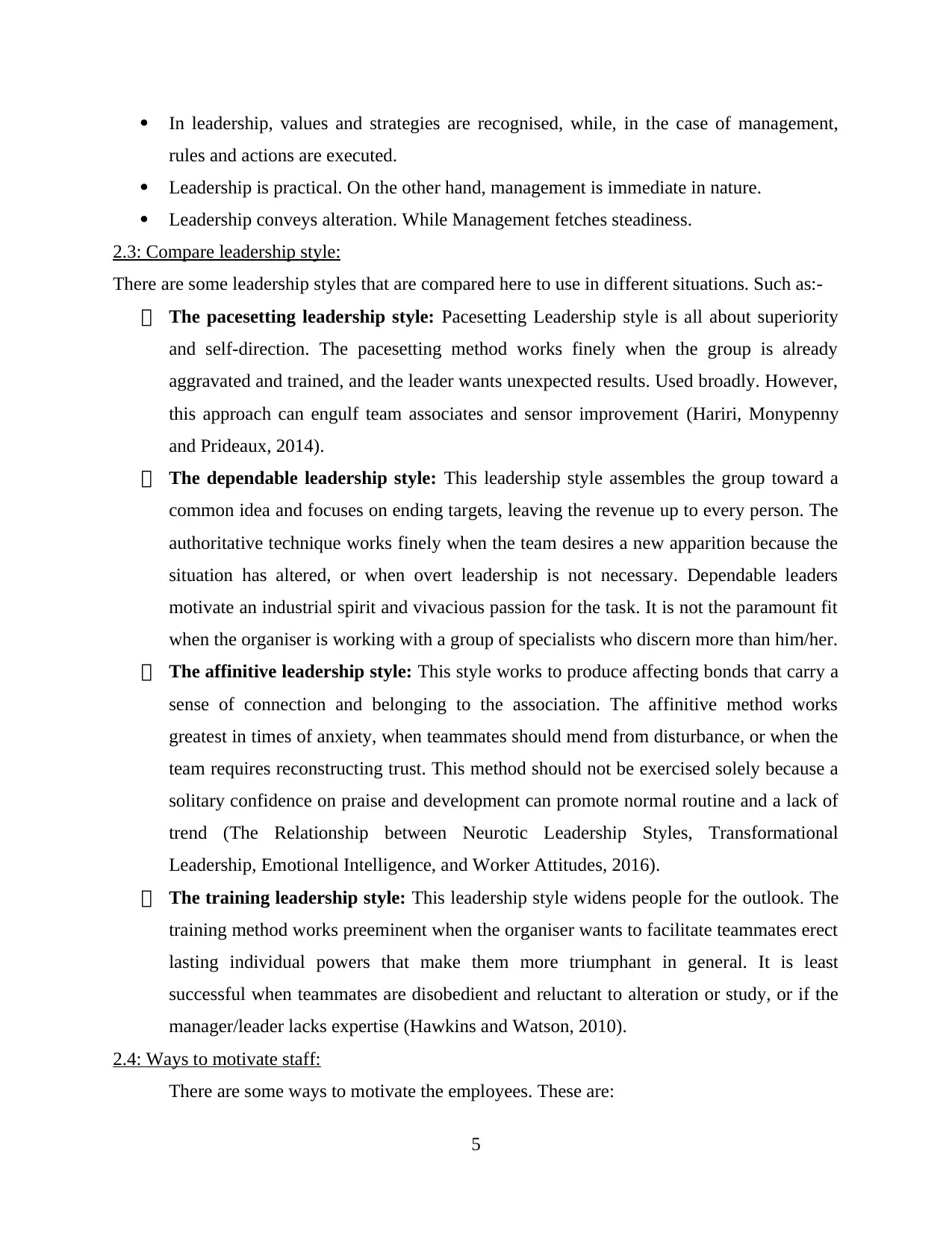
In leadership, values and strategies are recognised, while, in the case of management,
rules and actions are executed.
Leadership is practical. On the other hand, management is immediate in nature.
Leadership conveys alteration. While Management fetches steadiness.
2.3: Compare leadership style:
There are some leadership styles that are compared here to use in different situations. Such as:-
The pacesetting leadership style: Pacesetting Leadership style is all about superiority
and self-direction. The pacesetting method works finely when the group is already
aggravated and trained, and the leader wants unexpected results. Used broadly. However,
this approach can engulf team associates and sensor improvement (Hariri, Monypenny
and Prideaux, 2014).
The dependable leadership style: This leadership style assembles the group toward a
common idea and focuses on ending targets, leaving the revenue up to every person. The
authoritative technique works finely when the team desires a new apparition because the
situation has altered, or when overt leadership is not necessary. Dependable leaders
motivate an industrial spirit and vivacious passion for the task. It is not the paramount fit
when the organiser is working with a group of specialists who discern more than him/her.
The affinitive leadership style: This style works to produce affecting bonds that carry a
sense of connection and belonging to the association. The affinitive method works
greatest in times of anxiety, when teammates should mend from disturbance, or when the
team requires reconstructing trust. This method should not be exercised solely because a
solitary confidence on praise and development can promote normal routine and a lack of
trend (The Relationship between Neurotic Leadership Styles, Transformational
Leadership, Emotional Intelligence, and Worker Attitudes, 2016).
The training leadership style: This leadership style widens people for the outlook. The
training method works preeminent when the organiser wants to facilitate teammates erect
lasting individual powers that make them more triumphant in general. It is least
successful when teammates are disobedient and reluctant to alteration or study, or if the
manager/leader lacks expertise (Hawkins and Watson, 2010).
2.4: Ways to motivate staff:
There are some ways to motivate the employees. These are:
5
rules and actions are executed.
Leadership is practical. On the other hand, management is immediate in nature.
Leadership conveys alteration. While Management fetches steadiness.
2.3: Compare leadership style:
There are some leadership styles that are compared here to use in different situations. Such as:-
The pacesetting leadership style: Pacesetting Leadership style is all about superiority
and self-direction. The pacesetting method works finely when the group is already
aggravated and trained, and the leader wants unexpected results. Used broadly. However,
this approach can engulf team associates and sensor improvement (Hariri, Monypenny
and Prideaux, 2014).
The dependable leadership style: This leadership style assembles the group toward a
common idea and focuses on ending targets, leaving the revenue up to every person. The
authoritative technique works finely when the team desires a new apparition because the
situation has altered, or when overt leadership is not necessary. Dependable leaders
motivate an industrial spirit and vivacious passion for the task. It is not the paramount fit
when the organiser is working with a group of specialists who discern more than him/her.
The affinitive leadership style: This style works to produce affecting bonds that carry a
sense of connection and belonging to the association. The affinitive method works
greatest in times of anxiety, when teammates should mend from disturbance, or when the
team requires reconstructing trust. This method should not be exercised solely because a
solitary confidence on praise and development can promote normal routine and a lack of
trend (The Relationship between Neurotic Leadership Styles, Transformational
Leadership, Emotional Intelligence, and Worker Attitudes, 2016).
The training leadership style: This leadership style widens people for the outlook. The
training method works preeminent when the organiser wants to facilitate teammates erect
lasting individual powers that make them more triumphant in general. It is least
successful when teammates are disobedient and reluctant to alteration or study, or if the
manager/leader lacks expertise (Hawkins and Watson, 2010).
2.4: Ways to motivate staff:
There are some ways to motivate the employees. These are:
5
Paraphrase This Document
Need a fresh take? Get an instant paraphrase of this document with our AI Paraphraser
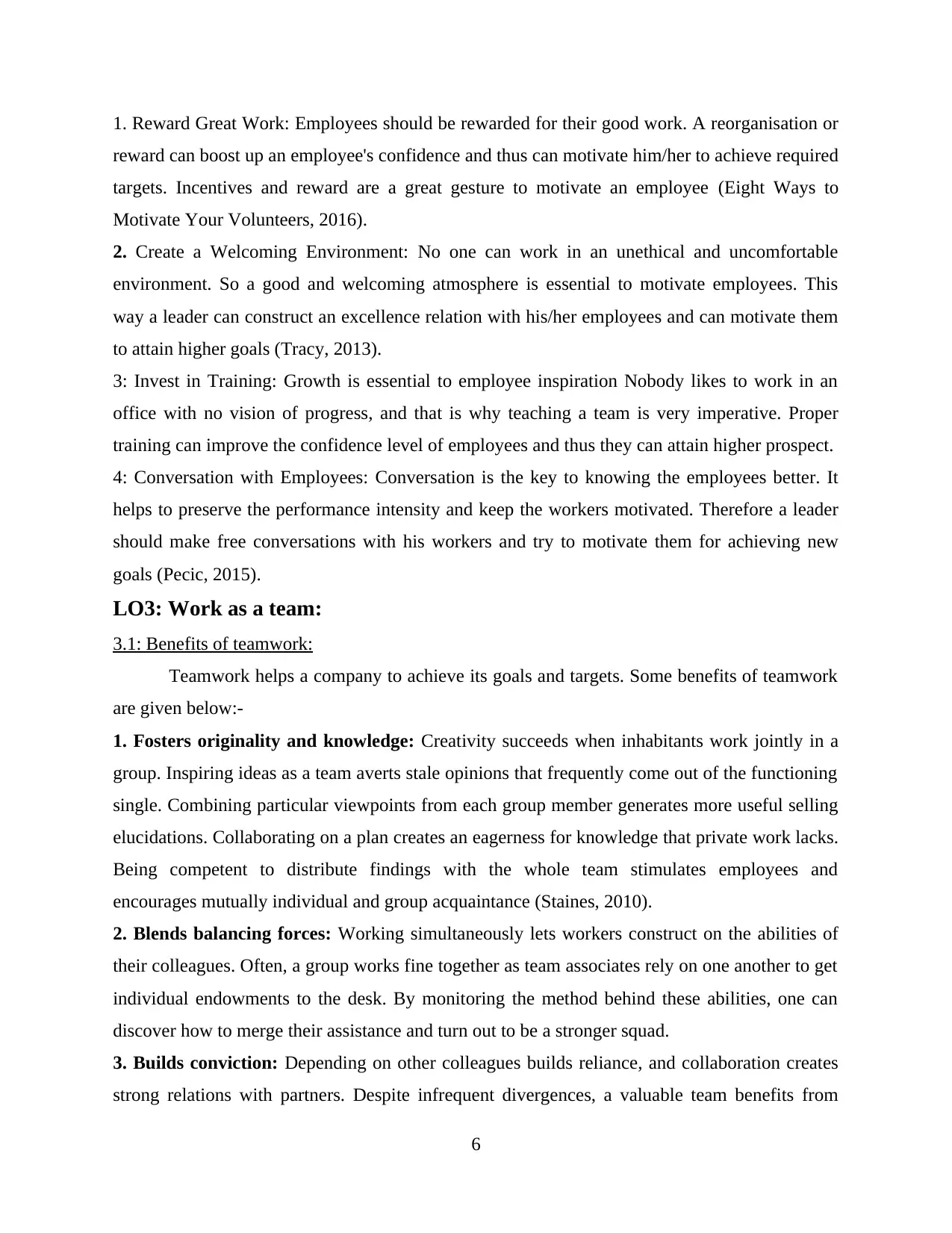
1. Reward Great Work: Employees should be rewarded for their good work. A reorganisation or
reward can boost up an employee's confidence and thus can motivate him/her to achieve required
targets. Incentives and reward are a great gesture to motivate an employee (Eight Ways to
Motivate Your Volunteers, 2016).
2. Create a Welcoming Environment: No one can work in an unethical and uncomfortable
environment. So a good and welcoming atmosphere is essential to motivate employees. This
way a leader can construct an excellence relation with his/her employees and can motivate them
to attain higher goals (Tracy, 2013).
3: Invest in Training: Growth is essential to employee inspiration Nobody likes to work in an
office with no vision of progress, and that is why teaching a team is very imperative. Proper
training can improve the confidence level of employees and thus they can attain higher prospect.
4: Conversation with Employees: Conversation is the key to knowing the employees better. It
helps to preserve the performance intensity and keep the workers motivated. Therefore a leader
should make free conversations with his workers and try to motivate them for achieving new
goals (Pecic, 2015).
LO3: Work as a team:
3.1: Benefits of teamwork:
Teamwork helps a company to achieve its goals and targets. Some benefits of teamwork
are given below:-
1. Fosters originality and knowledge: Creativity succeeds when inhabitants work jointly in a
group. Inspiring ideas as a team averts stale opinions that frequently come out of the functioning
single. Combining particular viewpoints from each group member generates more useful selling
elucidations. Collaborating on a plan creates an eagerness for knowledge that private work lacks.
Being competent to distribute findings with the whole team stimulates employees and
encourages mutually individual and group acquaintance (Staines, 2010).
2. Blends balancing forces: Working simultaneously lets workers construct on the abilities of
their colleagues. Often, a group works fine together as team associates rely on one another to get
individual endowments to the desk. By monitoring the method behind these abilities, one can
discover how to merge their assistance and turn out to be a stronger squad.
3. Builds conviction: Depending on other colleagues builds reliance, and collaboration creates
strong relations with partners. Despite infrequent divergences, a valuable team benefits from
6
reward can boost up an employee's confidence and thus can motivate him/her to achieve required
targets. Incentives and reward are a great gesture to motivate an employee (Eight Ways to
Motivate Your Volunteers, 2016).
2. Create a Welcoming Environment: No one can work in an unethical and uncomfortable
environment. So a good and welcoming atmosphere is essential to motivate employees. This
way a leader can construct an excellence relation with his/her employees and can motivate them
to attain higher goals (Tracy, 2013).
3: Invest in Training: Growth is essential to employee inspiration Nobody likes to work in an
office with no vision of progress, and that is why teaching a team is very imperative. Proper
training can improve the confidence level of employees and thus they can attain higher prospect.
4: Conversation with Employees: Conversation is the key to knowing the employees better. It
helps to preserve the performance intensity and keep the workers motivated. Therefore a leader
should make free conversations with his workers and try to motivate them for achieving new
goals (Pecic, 2015).
LO3: Work as a team:
3.1: Benefits of teamwork:
Teamwork helps a company to achieve its goals and targets. Some benefits of teamwork
are given below:-
1. Fosters originality and knowledge: Creativity succeeds when inhabitants work jointly in a
group. Inspiring ideas as a team averts stale opinions that frequently come out of the functioning
single. Combining particular viewpoints from each group member generates more useful selling
elucidations. Collaborating on a plan creates an eagerness for knowledge that private work lacks.
Being competent to distribute findings with the whole team stimulates employees and
encourages mutually individual and group acquaintance (Staines, 2010).
2. Blends balancing forces: Working simultaneously lets workers construct on the abilities of
their colleagues. Often, a group works fine together as team associates rely on one another to get
individual endowments to the desk. By monitoring the method behind these abilities, one can
discover how to merge their assistance and turn out to be a stronger squad.
3. Builds conviction: Depending on other colleagues builds reliance, and collaboration creates
strong relations with partners. Despite infrequent divergences, a valuable team benefits from
6
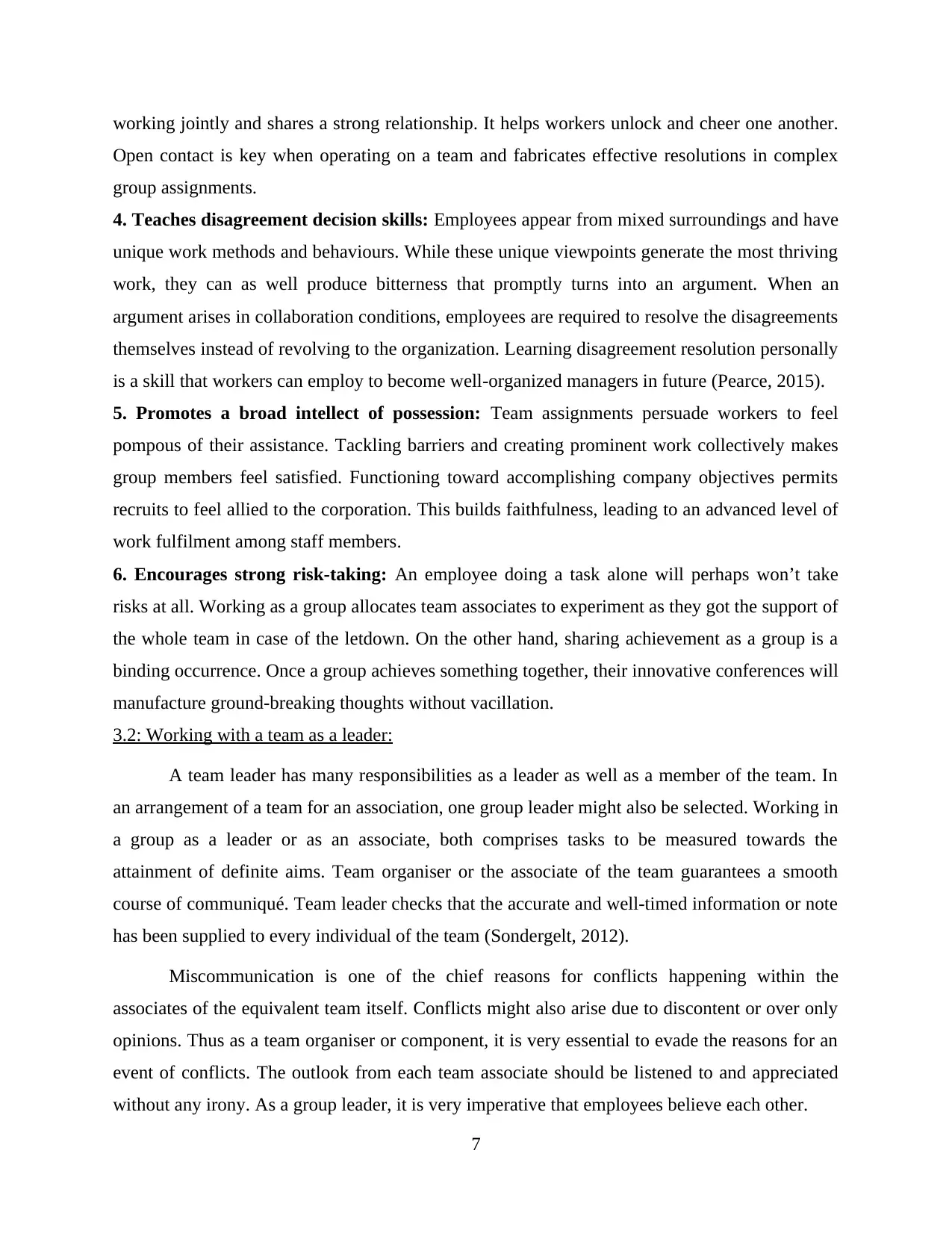
working jointly and shares a strong relationship. It helps workers unlock and cheer one another.
Open contact is key when operating on a team and fabricates effective resolutions in complex
group assignments.
4. Teaches disagreement decision skills: Employees appear from mixed surroundings and have
unique work methods and behaviours. While these unique viewpoints generate the most thriving
work, they can as well produce bitterness that promptly turns into an argument. When an
argument arises in collaboration conditions, employees are required to resolve the disagreements
themselves instead of revolving to the organization. Learning disagreement resolution personally
is a skill that workers can employ to become well-organized managers in future (Pearce, 2015).
5. Promotes a broad intellect of possession: Team assignments persuade workers to feel
pompous of their assistance. Tackling barriers and creating prominent work collectively makes
group members feel satisfied. Functioning toward accomplishing company objectives permits
recruits to feel allied to the corporation. This builds faithfulness, leading to an advanced level of
work fulfilment among staff members.
6. Encourages strong risk-taking: An employee doing a task alone will perhaps won’t take
risks at all. Working as a group allocates team associates to experiment as they got the support of
the whole team in case of the letdown. On the other hand, sharing achievement as a group is a
binding occurrence. Once a group achieves something together, their innovative conferences will
manufacture ground-breaking thoughts without vacillation.
3.2: Working with a team as a leader:
A team leader has many responsibilities as a leader as well as a member of the team. In
an arrangement of a team for an association, one group leader might also be selected. Working in
a group as a leader or as an associate, both comprises tasks to be measured towards the
attainment of definite aims. Team organiser or the associate of the team guarantees a smooth
course of communiqué. Team leader checks that the accurate and well-timed information or note
has been supplied to every individual of the team (Sondergelt, 2012).
Miscommunication is one of the chief reasons for conflicts happening within the
associates of the equivalent team itself. Conflicts might also arise due to discontent or over only
opinions. Thus as a team organiser or component, it is very essential to evade the reasons for an
event of conflicts. The outlook from each team associate should be listened to and appreciated
without any irony. As a group leader, it is very imperative that employees believe each other.
7
Open contact is key when operating on a team and fabricates effective resolutions in complex
group assignments.
4. Teaches disagreement decision skills: Employees appear from mixed surroundings and have
unique work methods and behaviours. While these unique viewpoints generate the most thriving
work, they can as well produce bitterness that promptly turns into an argument. When an
argument arises in collaboration conditions, employees are required to resolve the disagreements
themselves instead of revolving to the organization. Learning disagreement resolution personally
is a skill that workers can employ to become well-organized managers in future (Pearce, 2015).
5. Promotes a broad intellect of possession: Team assignments persuade workers to feel
pompous of their assistance. Tackling barriers and creating prominent work collectively makes
group members feel satisfied. Functioning toward accomplishing company objectives permits
recruits to feel allied to the corporation. This builds faithfulness, leading to an advanced level of
work fulfilment among staff members.
6. Encourages strong risk-taking: An employee doing a task alone will perhaps won’t take
risks at all. Working as a group allocates team associates to experiment as they got the support of
the whole team in case of the letdown. On the other hand, sharing achievement as a group is a
binding occurrence. Once a group achieves something together, their innovative conferences will
manufacture ground-breaking thoughts without vacillation.
3.2: Working with a team as a leader:
A team leader has many responsibilities as a leader as well as a member of the team. In
an arrangement of a team for an association, one group leader might also be selected. Working in
a group as a leader or as an associate, both comprises tasks to be measured towards the
attainment of definite aims. Team organiser or the associate of the team guarantees a smooth
course of communiqué. Team leader checks that the accurate and well-timed information or note
has been supplied to every individual of the team (Sondergelt, 2012).
Miscommunication is one of the chief reasons for conflicts happening within the
associates of the equivalent team itself. Conflicts might also arise due to discontent or over only
opinions. Thus as a team organiser or component, it is very essential to evade the reasons for an
event of conflicts. The outlook from each team associate should be listened to and appreciated
without any irony. As a group leader, it is very imperative that employees believe each other.
7
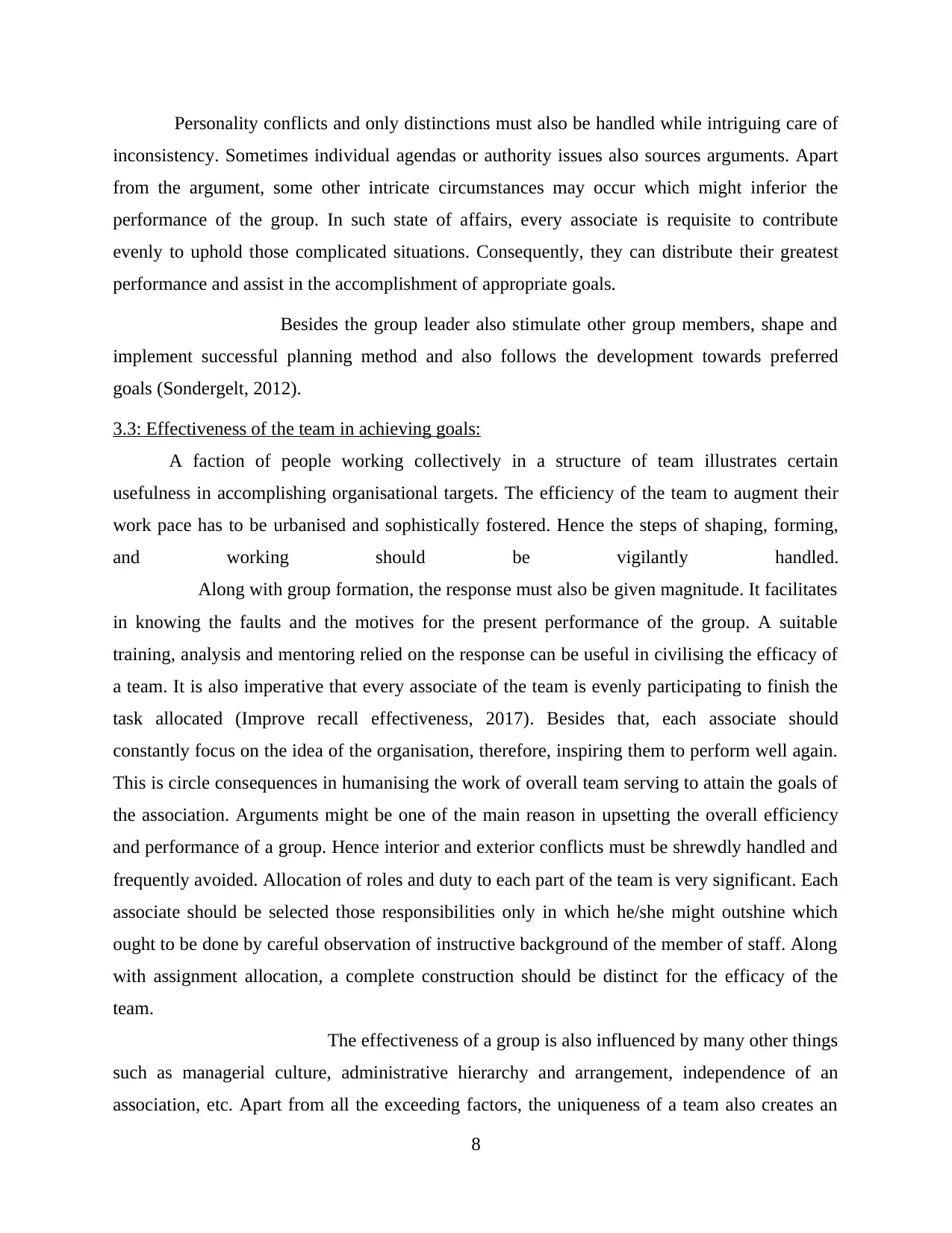
Personality conflicts and only distinctions must also be handled while intriguing care of
inconsistency. Sometimes individual agendas or authority issues also sources arguments. Apart
from the argument, some other intricate circumstances may occur which might inferior the
performance of the group. In such state of affairs, every associate is requisite to contribute
evenly to uphold those complicated situations. Consequently, they can distribute their greatest
performance and assist in the accomplishment of appropriate goals.
Besides the group leader also stimulate other group members, shape and
implement successful planning method and also follows the development towards preferred
goals (Sondergelt, 2012).
3.3: Effectiveness of the team in achieving goals:
A faction of people working collectively in a structure of team illustrates certain
usefulness in accomplishing organisational targets. The efficiency of the team to augment their
work pace has to be urbanised and sophistically fostered. Hence the steps of shaping, forming,
and working should be vigilantly handled.
Along with group formation, the response must also be given magnitude. It facilitates
in knowing the faults and the motives for the present performance of the group. A suitable
training, analysis and mentoring relied on the response can be useful in civilising the efficacy of
a team. It is also imperative that every associate of the team is evenly participating to finish the
task allocated (Improve recall effectiveness, 2017). Besides that, each associate should
constantly focus on the idea of the organisation, therefore, inspiring them to perform well again.
This is circle consequences in humanising the work of overall team serving to attain the goals of
the association. Arguments might be one of the main reason in upsetting the overall efficiency
and performance of a group. Hence interior and exterior conflicts must be shrewdly handled and
frequently avoided. Allocation of roles and duty to each part of the team is very significant. Each
associate should be selected those responsibilities only in which he/she might outshine which
ought to be done by careful observation of instructive background of the member of staff. Along
with assignment allocation, a complete construction should be distinct for the efficacy of the
team.
The effectiveness of a group is also influenced by many other things
such as managerial culture, administrative hierarchy and arrangement, independence of an
association, etc. Apart from all the exceeding factors, the uniqueness of a team also creates an
8
inconsistency. Sometimes individual agendas or authority issues also sources arguments. Apart
from the argument, some other intricate circumstances may occur which might inferior the
performance of the group. In such state of affairs, every associate is requisite to contribute
evenly to uphold those complicated situations. Consequently, they can distribute their greatest
performance and assist in the accomplishment of appropriate goals.
Besides the group leader also stimulate other group members, shape and
implement successful planning method and also follows the development towards preferred
goals (Sondergelt, 2012).
3.3: Effectiveness of the team in achieving goals:
A faction of people working collectively in a structure of team illustrates certain
usefulness in accomplishing organisational targets. The efficiency of the team to augment their
work pace has to be urbanised and sophistically fostered. Hence the steps of shaping, forming,
and working should be vigilantly handled.
Along with group formation, the response must also be given magnitude. It facilitates
in knowing the faults and the motives for the present performance of the group. A suitable
training, analysis and mentoring relied on the response can be useful in civilising the efficacy of
a team. It is also imperative that every associate of the team is evenly participating to finish the
task allocated (Improve recall effectiveness, 2017). Besides that, each associate should
constantly focus on the idea of the organisation, therefore, inspiring them to perform well again.
This is circle consequences in humanising the work of overall team serving to attain the goals of
the association. Arguments might be one of the main reason in upsetting the overall efficiency
and performance of a group. Hence interior and exterior conflicts must be shrewdly handled and
frequently avoided. Allocation of roles and duty to each part of the team is very significant. Each
associate should be selected those responsibilities only in which he/she might outshine which
ought to be done by careful observation of instructive background of the member of staff. Along
with assignment allocation, a complete construction should be distinct for the efficacy of the
team.
The effectiveness of a group is also influenced by many other things
such as managerial culture, administrative hierarchy and arrangement, independence of an
association, etc. Apart from all the exceeding factors, the uniqueness of a team also creates an
8
Secure Best Marks with AI Grader
Need help grading? Try our AI Grader for instant feedback on your assignments.
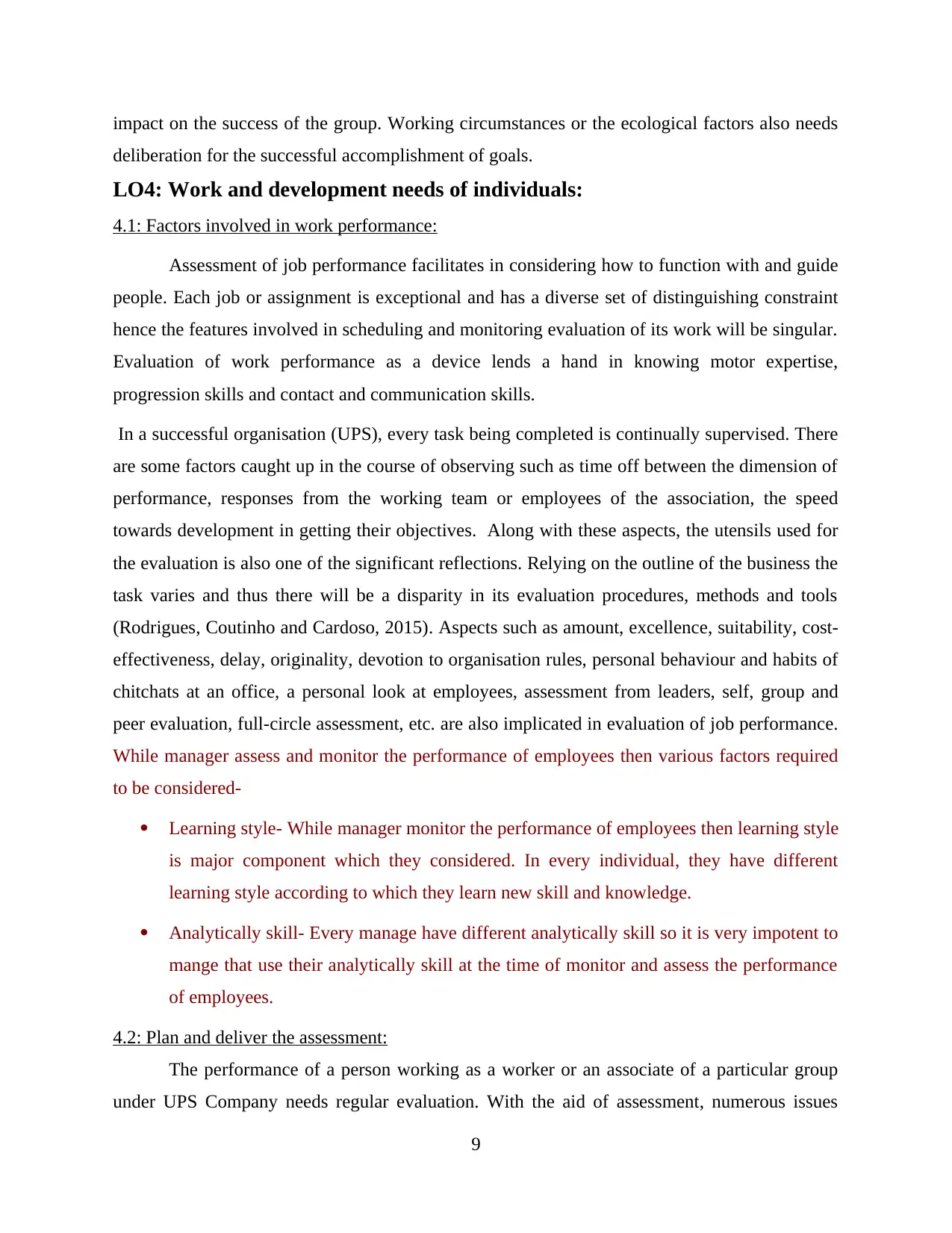
impact on the success of the group. Working circumstances or the ecological factors also needs
deliberation for the successful accomplishment of goals.
LO4: Work and development needs of individuals:
4.1: Factors involved in work performance:
Assessment of job performance facilitates in considering how to function with and guide
people. Each job or assignment is exceptional and has a diverse set of distinguishing constraint
hence the features involved in scheduling and monitoring evaluation of its work will be singular.
Evaluation of work performance as a device lends a hand in knowing motor expertise,
progression skills and contact and communication skills.
In a successful organisation (UPS), every task being completed is continually supervised. There
are some factors caught up in the course of observing such as time off between the dimension of
performance, responses from the working team or employees of the association, the speed
towards development in getting their objectives. Along with these aspects, the utensils used for
the evaluation is also one of the significant reflections. Relying on the outline of the business the
task varies and thus there will be a disparity in its evaluation procedures, methods and tools
(Rodrigues, Coutinho and Cardoso, 2015). Aspects such as amount, excellence, suitability, cost-
effectiveness, delay, originality, devotion to organisation rules, personal behaviour and habits of
chitchats at an office, a personal look at employees, assessment from leaders, self, group and
peer evaluation, full-circle assessment, etc. are also implicated in evaluation of job performance.
While manager assess and monitor the performance of employees then various factors required
to be considered-
Learning style- While manager monitor the performance of employees then learning style
is major component which they considered. In every individual, they have different
learning style according to which they learn new skill and knowledge.
Analytically skill- Every manage have different analytically skill so it is very impotent to
mange that use their analytically skill at the time of monitor and assess the performance
of employees.
4.2: Plan and deliver the assessment:
The performance of a person working as a worker or an associate of a particular group
under UPS Company needs regular evaluation. With the aid of assessment, numerous issues
9
deliberation for the successful accomplishment of goals.
LO4: Work and development needs of individuals:
4.1: Factors involved in work performance:
Assessment of job performance facilitates in considering how to function with and guide
people. Each job or assignment is exceptional and has a diverse set of distinguishing constraint
hence the features involved in scheduling and monitoring evaluation of its work will be singular.
Evaluation of work performance as a device lends a hand in knowing motor expertise,
progression skills and contact and communication skills.
In a successful organisation (UPS), every task being completed is continually supervised. There
are some factors caught up in the course of observing such as time off between the dimension of
performance, responses from the working team or employees of the association, the speed
towards development in getting their objectives. Along with these aspects, the utensils used for
the evaluation is also one of the significant reflections. Relying on the outline of the business the
task varies and thus there will be a disparity in its evaluation procedures, methods and tools
(Rodrigues, Coutinho and Cardoso, 2015). Aspects such as amount, excellence, suitability, cost-
effectiveness, delay, originality, devotion to organisation rules, personal behaviour and habits of
chitchats at an office, a personal look at employees, assessment from leaders, self, group and
peer evaluation, full-circle assessment, etc. are also implicated in evaluation of job performance.
While manager assess and monitor the performance of employees then various factors required
to be considered-
Learning style- While manager monitor the performance of employees then learning style
is major component which they considered. In every individual, they have different
learning style according to which they learn new skill and knowledge.
Analytically skill- Every manage have different analytically skill so it is very impotent to
mange that use their analytically skill at the time of monitor and assess the performance
of employees.
4.2: Plan and deliver the assessment:
The performance of a person working as a worker or an associate of a particular group
under UPS Company needs regular evaluation. With the aid of assessment, numerous issues
9
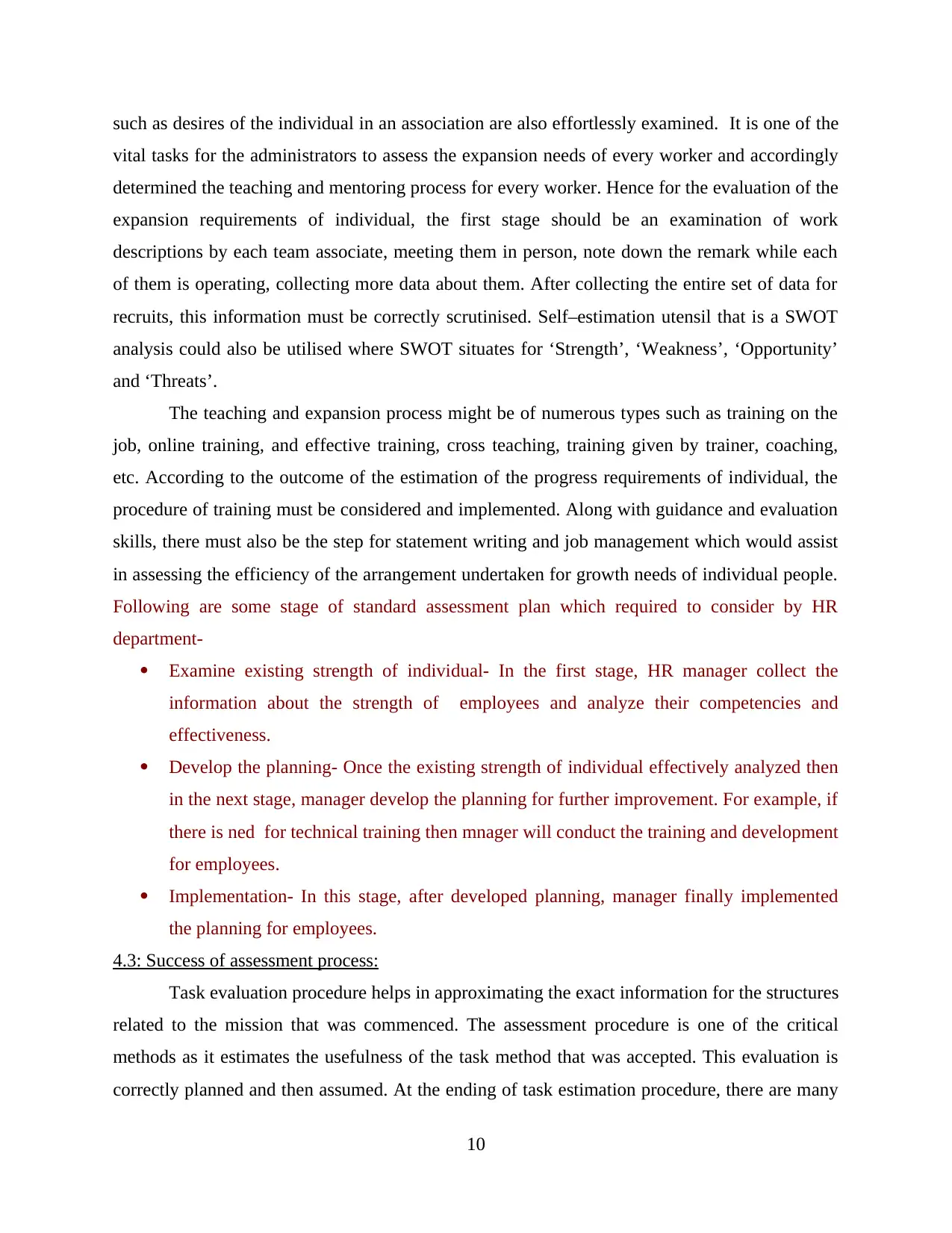
such as desires of the individual in an association are also effortlessly examined. It is one of the
vital tasks for the administrators to assess the expansion needs of every worker and accordingly
determined the teaching and mentoring process for every worker. Hence for the evaluation of the
expansion requirements of individual, the first stage should be an examination of work
descriptions by each team associate, meeting them in person, note down the remark while each
of them is operating, collecting more data about them. After collecting the entire set of data for
recruits, this information must be correctly scrutinised. Self–estimation utensil that is a SWOT
analysis could also be utilised where SWOT situates for ‘Strength’, ‘Weakness’, ‘Opportunity’
and ‘Threats’.
The teaching and expansion process might be of numerous types such as training on the
job, online training, and effective training, cross teaching, training given by trainer, coaching,
etc. According to the outcome of the estimation of the progress requirements of individual, the
procedure of training must be considered and implemented. Along with guidance and evaluation
skills, there must also be the step for statement writing and job management which would assist
in assessing the efficiency of the arrangement undertaken for growth needs of individual people.
Following are some stage of standard assessment plan which required to consider by HR
department-
Examine existing strength of individual- In the first stage, HR manager collect the
information about the strength of employees and analyze their competencies and
effectiveness.
Develop the planning- Once the existing strength of individual effectively analyzed then
in the next stage, manager develop the planning for further improvement. For example, if
there is ned for technical training then mnager will conduct the training and development
for employees.
Implementation- In this stage, after developed planning, manager finally implemented
the planning for employees.
4.3: Success of assessment process:
Task evaluation procedure helps in approximating the exact information for the structures
related to the mission that was commenced. The assessment procedure is one of the critical
methods as it estimates the usefulness of the task method that was accepted. This evaluation is
correctly planned and then assumed. At the ending of task estimation procedure, there are many
10
vital tasks for the administrators to assess the expansion needs of every worker and accordingly
determined the teaching and mentoring process for every worker. Hence for the evaluation of the
expansion requirements of individual, the first stage should be an examination of work
descriptions by each team associate, meeting them in person, note down the remark while each
of them is operating, collecting more data about them. After collecting the entire set of data for
recruits, this information must be correctly scrutinised. Self–estimation utensil that is a SWOT
analysis could also be utilised where SWOT situates for ‘Strength’, ‘Weakness’, ‘Opportunity’
and ‘Threats’.
The teaching and expansion process might be of numerous types such as training on the
job, online training, and effective training, cross teaching, training given by trainer, coaching,
etc. According to the outcome of the estimation of the progress requirements of individual, the
procedure of training must be considered and implemented. Along with guidance and evaluation
skills, there must also be the step for statement writing and job management which would assist
in assessing the efficiency of the arrangement undertaken for growth needs of individual people.
Following are some stage of standard assessment plan which required to consider by HR
department-
Examine existing strength of individual- In the first stage, HR manager collect the
information about the strength of employees and analyze their competencies and
effectiveness.
Develop the planning- Once the existing strength of individual effectively analyzed then
in the next stage, manager develop the planning for further improvement. For example, if
there is ned for technical training then mnager will conduct the training and development
for employees.
Implementation- In this stage, after developed planning, manager finally implemented
the planning for employees.
4.3: Success of assessment process:
Task evaluation procedure helps in approximating the exact information for the structures
related to the mission that was commenced. The assessment procedure is one of the critical
methods as it estimates the usefulness of the task method that was accepted. This evaluation is
correctly planned and then assumed. At the ending of task estimation procedure, there are many
10
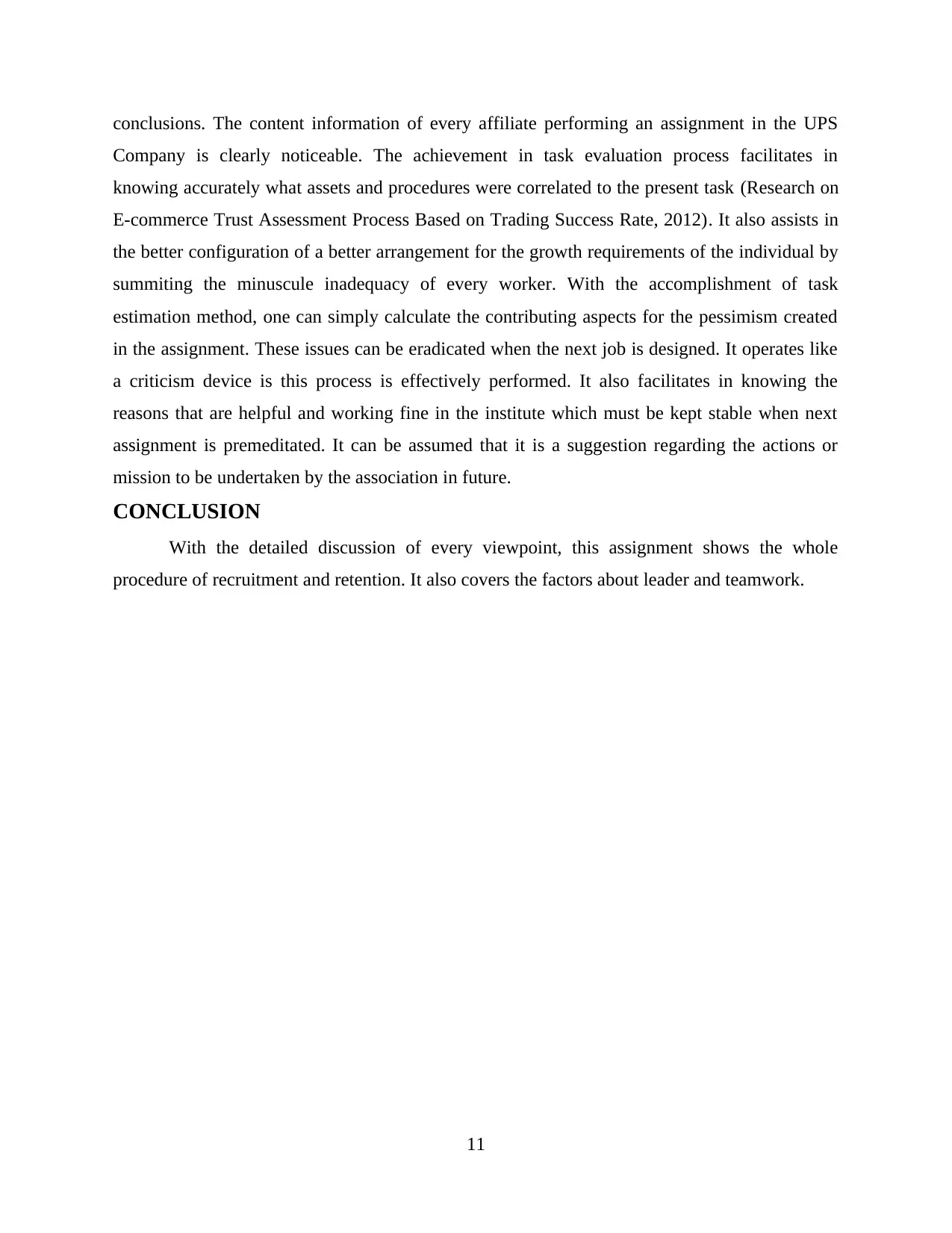
conclusions. The content information of every affiliate performing an assignment in the UPS
Company is clearly noticeable. The achievement in task evaluation process facilitates in
knowing accurately what assets and procedures were correlated to the present task (Research on
E-commerce Trust Assessment Process Based on Trading Success Rate, 2012). It also assists in
the better configuration of a better arrangement for the growth requirements of the individual by
summiting the minuscule inadequacy of every worker. With the accomplishment of task
estimation method, one can simply calculate the contributing aspects for the pessimism created
in the assignment. These issues can be eradicated when the next job is designed. It operates like
a criticism device is this process is effectively performed. It also facilitates in knowing the
reasons that are helpful and working fine in the institute which must be kept stable when next
assignment is premeditated. It can be assumed that it is a suggestion regarding the actions or
mission to be undertaken by the association in future.
CONCLUSION
With the detailed discussion of every viewpoint, this assignment shows the whole
procedure of recruitment and retention. It also covers the factors about leader and teamwork.
11
Company is clearly noticeable. The achievement in task evaluation process facilitates in
knowing accurately what assets and procedures were correlated to the present task (Research on
E-commerce Trust Assessment Process Based on Trading Success Rate, 2012). It also assists in
the better configuration of a better arrangement for the growth requirements of the individual by
summiting the minuscule inadequacy of every worker. With the accomplishment of task
estimation method, one can simply calculate the contributing aspects for the pessimism created
in the assignment. These issues can be eradicated when the next job is designed. It operates like
a criticism device is this process is effectively performed. It also facilitates in knowing the
reasons that are helpful and working fine in the institute which must be kept stable when next
assignment is premeditated. It can be assumed that it is a suggestion regarding the actions or
mission to be undertaken by the association in future.
CONCLUSION
With the detailed discussion of every viewpoint, this assignment shows the whole
procedure of recruitment and retention. It also covers the factors about leader and teamwork.
11
Paraphrase This Document
Need a fresh take? Get an instant paraphrase of this document with our AI Paraphraser
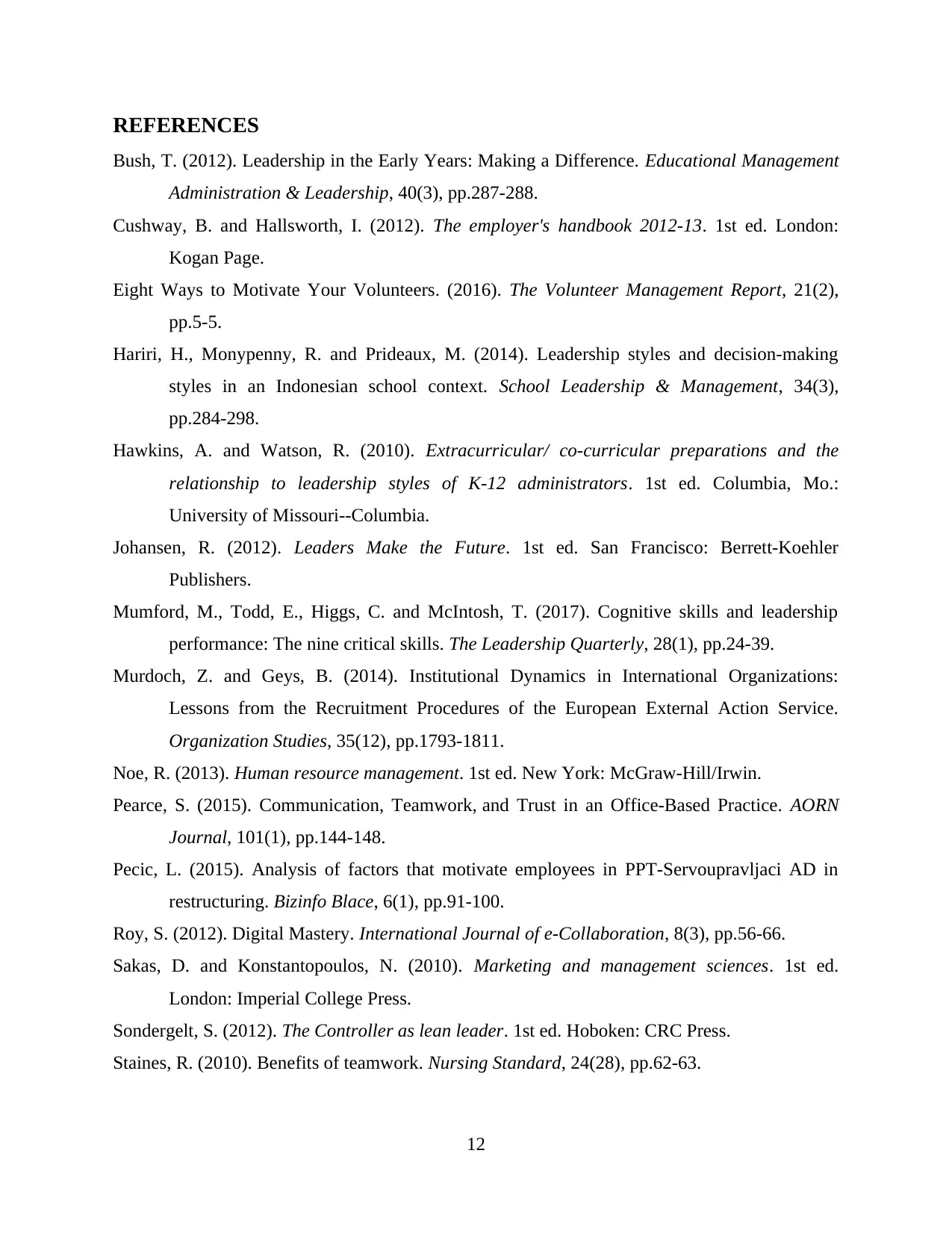
REFERENCES
Bush, T. (2012). Leadership in the Early Years: Making a Difference. Educational Management
Administration & Leadership, 40(3), pp.287-288.
Cushway, B. and Hallsworth, I. (2012). The employer's handbook 2012-13. 1st ed. London:
Kogan Page.
Eight Ways to Motivate Your Volunteers. (2016). The Volunteer Management Report, 21(2),
pp.5-5.
Hariri, H., Monypenny, R. and Prideaux, M. (2014). Leadership styles and decision-making
styles in an Indonesian school context. School Leadership & Management, 34(3),
pp.284-298.
Hawkins, A. and Watson, R. (2010). Extracurricular/ co-curricular preparations and the
relationship to leadership styles of K-12 administrators. 1st ed. Columbia, Mo.:
University of Missouri--Columbia.
Johansen, R. (2012). Leaders Make the Future. 1st ed. San Francisco: Berrett-Koehler
Publishers.
Mumford, M., Todd, E., Higgs, C. and McIntosh, T. (2017). Cognitive skills and leadership
performance: The nine critical skills. The Leadership Quarterly, 28(1), pp.24-39.
Murdoch, Z. and Geys, B. (2014). Institutional Dynamics in International Organizations:
Lessons from the Recruitment Procedures of the European External Action Service.
Organization Studies, 35(12), pp.1793-1811.
Noe, R. (2013). Human resource management. 1st ed. New York: McGraw-Hill/Irwin.
Pearce, S. (2015). Communication, Teamwork, and Trust in an Office-Based Practice. AORN
Journal, 101(1), pp.144-148.
Pecic, L. (2015). Analysis of factors that motivate employees in PPT-Servoupravljaci AD in
restructuring. Bizinfo Blace, 6(1), pp.91-100.
Roy, S. (2012). Digital Mastery. International Journal of e-Collaboration, 8(3), pp.56-66.
Sakas, D. and Konstantopoulos, N. (2010). Marketing and management sciences. 1st ed.
London: Imperial College Press.
Sondergelt, S. (2012). The Controller as lean leader. 1st ed. Hoboken: CRC Press.
Staines, R. (2010). Benefits of teamwork. Nursing Standard, 24(28), pp.62-63.
12
Bush, T. (2012). Leadership in the Early Years: Making a Difference. Educational Management
Administration & Leadership, 40(3), pp.287-288.
Cushway, B. and Hallsworth, I. (2012). The employer's handbook 2012-13. 1st ed. London:
Kogan Page.
Eight Ways to Motivate Your Volunteers. (2016). The Volunteer Management Report, 21(2),
pp.5-5.
Hariri, H., Monypenny, R. and Prideaux, M. (2014). Leadership styles and decision-making
styles in an Indonesian school context. School Leadership & Management, 34(3),
pp.284-298.
Hawkins, A. and Watson, R. (2010). Extracurricular/ co-curricular preparations and the
relationship to leadership styles of K-12 administrators. 1st ed. Columbia, Mo.:
University of Missouri--Columbia.
Johansen, R. (2012). Leaders Make the Future. 1st ed. San Francisco: Berrett-Koehler
Publishers.
Mumford, M., Todd, E., Higgs, C. and McIntosh, T. (2017). Cognitive skills and leadership
performance: The nine critical skills. The Leadership Quarterly, 28(1), pp.24-39.
Murdoch, Z. and Geys, B. (2014). Institutional Dynamics in International Organizations:
Lessons from the Recruitment Procedures of the European External Action Service.
Organization Studies, 35(12), pp.1793-1811.
Noe, R. (2013). Human resource management. 1st ed. New York: McGraw-Hill/Irwin.
Pearce, S. (2015). Communication, Teamwork, and Trust in an Office-Based Practice. AORN
Journal, 101(1), pp.144-148.
Pecic, L. (2015). Analysis of factors that motivate employees in PPT-Servoupravljaci AD in
restructuring. Bizinfo Blace, 6(1), pp.91-100.
Roy, S. (2012). Digital Mastery. International Journal of e-Collaboration, 8(3), pp.56-66.
Sakas, D. and Konstantopoulos, N. (2010). Marketing and management sciences. 1st ed.
London: Imperial College Press.
Sondergelt, S. (2012). The Controller as lean leader. 1st ed. Hoboken: CRC Press.
Staines, R. (2010). Benefits of teamwork. Nursing Standard, 24(28), pp.62-63.
12
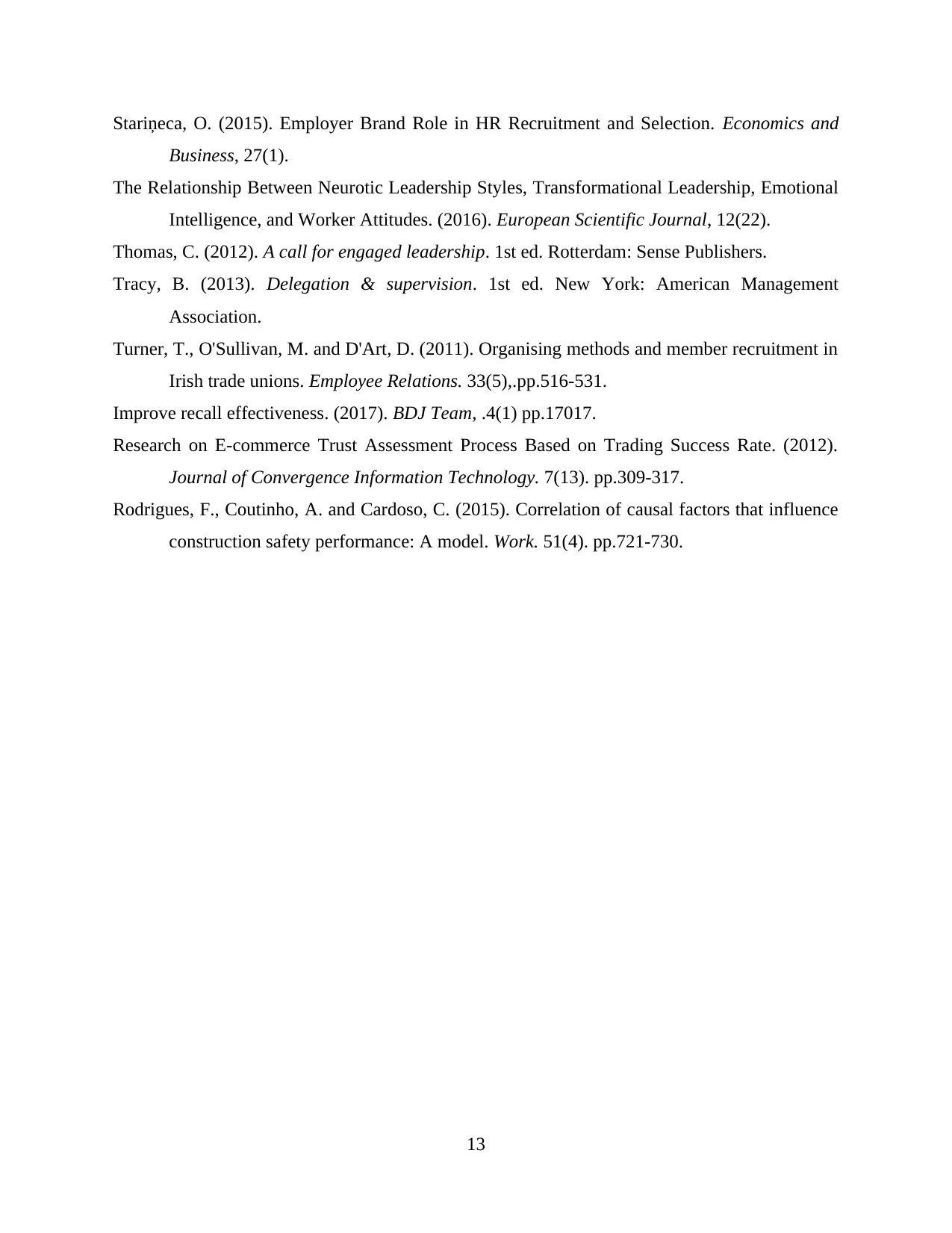
Stariņeca, O. (2015). Employer Brand Role in HR Recruitment and Selection. Economics and
Business, 27(1).
The Relationship Between Neurotic Leadership Styles, Transformational Leadership, Emotional
Intelligence, and Worker Attitudes. (2016). European Scientific Journal, 12(22).
Thomas, C. (2012). A call for engaged leadership. 1st ed. Rotterdam: Sense Publishers.
Tracy, B. (2013). Delegation & supervision. 1st ed. New York: American Management
Association.
Turner, T., O'Sullivan, M. and D'Art, D. (2011). Organising methods and member recruitment in
Irish trade unions. Employee Relations. 33(5),.pp.516-531.
Improve recall effectiveness. (2017). BDJ Team, .4(1) pp.17017.
Research on E-commerce Trust Assessment Process Based on Trading Success Rate. (2012).
Journal of Convergence Information Technology. 7(13). pp.309-317.
Rodrigues, F., Coutinho, A. and Cardoso, C. (2015). Correlation of causal factors that influence
construction safety performance: A model. Work. 51(4). pp.721-730.
13
Business, 27(1).
The Relationship Between Neurotic Leadership Styles, Transformational Leadership, Emotional
Intelligence, and Worker Attitudes. (2016). European Scientific Journal, 12(22).
Thomas, C. (2012). A call for engaged leadership. 1st ed. Rotterdam: Sense Publishers.
Tracy, B. (2013). Delegation & supervision. 1st ed. New York: American Management
Association.
Turner, T., O'Sullivan, M. and D'Art, D. (2011). Organising methods and member recruitment in
Irish trade unions. Employee Relations. 33(5),.pp.516-531.
Improve recall effectiveness. (2017). BDJ Team, .4(1) pp.17017.
Research on E-commerce Trust Assessment Process Based on Trading Success Rate. (2012).
Journal of Convergence Information Technology. 7(13). pp.309-317.
Rodrigues, F., Coutinho, A. and Cardoso, C. (2015). Correlation of causal factors that influence
construction safety performance: A model. Work. 51(4). pp.721-730.
13
1 out of 15
Related Documents
Your All-in-One AI-Powered Toolkit for Academic Success.
+13062052269
info@desklib.com
Available 24*7 on WhatsApp / Email
![[object Object]](/_next/static/media/star-bottom.7253800d.svg)
Unlock your academic potential
© 2024 | Zucol Services PVT LTD | All rights reserved.





